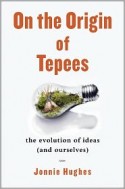
In Squaring Off, Zócalo invites authors into the public square to answer five probing questions about the essence of their books. For this round, we pose questions to Jonnie Hughes, author of On the Origin of Tepees: How Human Culture Evolves.
While the rules of natural selection apply to the behaviors of all living things, scientists have long debated how natural selection has influenced the evolution of human culture. Award-winning writer and documentary filmmaker Jonnie Hughes ventured into the American West to prove that some ideas die off while others adapt and thrive. The evolution of human culture, he argues, very closely follows the principles of natural selection – and this truth changes the way you look at everything.
1) You assert that all of us “look at the world through goggles.” But you ask us to ditch our current goggles in favor of your new ones. What’s wrong with the ones we have on, and what’s so great about these new goggles?

You’ve got me all wrong. I’m not making a judgment on any of the other pairs of goggles on humanity’s goggles rack. What I said was that there are no restrictions on the number of goggles we can wear. For instance, it’s easy to imagine a Democrat who’s an environmentalist and a Buddhist. That’s at least three pairs right there! What I do claim, however, is that I have a pair of goggles that you’ve probably never tried on, and I humbly suggest that you do try them just in case you find them as rewarding as I have. C’mon live a little. What have you got to lose?
2) While you wear these new goggles on most of your journey, at one point you say that are “too restrictive” and take them off. What happened?
Once you’ve been wearing these goggles for a while, you are faced with a startling revelation: that humanity — all that history, all that progress, all that we hold dear — is on autopilot. Our ideas are engaged in a Darwinian struggle for existence, selfish as genes, employing any means possible to inhabit our brains. We are mere bystanders, passive hosts of their struggle. You start to believe that we don’t have ideas; ideas have us.
That’s unsettling. The immediate response is throw the goggles off. That’s what I did at first, so that I could think it further through. If humanity is on autopilot, I countered, then how come it changes so fast and has achieved so much? Surely human genius must have been involved.
But I decided to resolve this by setting my goggles a challenge: could the rise of America from small indigenous communities to world superpower in less than 500 years be explained without factoring in human genius? Would I have the gall to conclude that no one really made America? The only way to find out was to put the goggles back on. And I tell you what: I never took them off again.
3) If we are mere bystanders to our own ideas, how do you explain why some ideas die off while others evolve? There must be some force driving them.

Exactamundo – there must be a force driving them. Biologists only recently discovered what drives the evolution of organisms: it is the competition between genes. Genes compete to be represented in the next generation. They’ll do anything to get over the line – even sacrifice the organism that has carried them up to it. That’s why Richard Dawkins calls genes “selfish.” Their only goal is to get to the next generation, and they’ll change their hosts in any way they need to in order to do that.
It was Dawkins who recognized that if culture evolves like biology, then there must be selfish little units at the heart of all culture, too. He called these little units “memes”. Now, memes are to cultural evolution what Higgs boson particles are to theoretical physics: we can’t see them (yet), and we don’t know exactly how they work (yet), but if they do exist, everything falls into place, and we get it.
4) As your title implies, you chose to focus on tepees as a way of understanding cultural evolution. Why tepees?
Darwin first spied natural selection at work in the biological world when travelling between the Galapagos Islands. On each successive island he found a resident finch species with a different shaped beak from the last. The Galapagos Island finches were, it turned out, one of the best demonstrations of natural selection on the planet.
I decided to try to find my own version of the Galapagos Islands in the cultural sphere. In this context, an island constitutes a group of human minds that share ideas among themselves but are isolated from other groups of human minds by a significant barrier — a “cultural sea”. The most obvious isolated “cultural islands” are tribes.
The Plains Indians, made up of iconic and ferociously independent tribes, were isolated until quite recently. Their cultures are well documented and many of their traditions are still alive and well. There’s probably no better cultural archipelago than the various tribes of the Plains Indians and no better “cultural finches” than their tepees. If I could go to each subsequent tribe and find a resident tepee, each shaped differently from the last, I might prove to my satisfaction that a process similar to natural selection was at work in human culture.
5) You say that this new way of looking at human beings solves the mysteries of our past and our present. What are those mysteries, and how does this new perspective solve them?
The mystery of our past is this: why did we evolve such a huge brain — an organic supercomputer — when all we needed was the equivalent of a pocket calculator to survive and reproduce in the East African savannah? That sort of over-evolution is illegal by the rules of natural selection.
The mystery of our present is this: how can our species alone carry on with such wanton disregard for its genes — “deciding” not to have kids, going to war to defend nothing more than an idea, adopting children from the developing world, and so forth? When you take the established gene’s-eye view, none of these actions makes any sense.
It’s easy to conclude that we’re beyond the rules, but that is no explanation. Only when we entertain the possibility of another selfish little unit at work in our midst do we gain any additional explanatory power. The meme and the gene in cahoots could have engineered the human being. The selective environment of a world in which they both exert their influence would in fact predict the evolution of an animal just like us. These new goggles give us a meme’s-eye view — a complement to the gene’s-eye view – and only through them can we truly understand our past, explain the extravagances of our present, and gain the foresight we need to actively create our future.
Buy the book: Skylight Books, Powell’s, Amazon
*Photo courtesy of left-hand.



